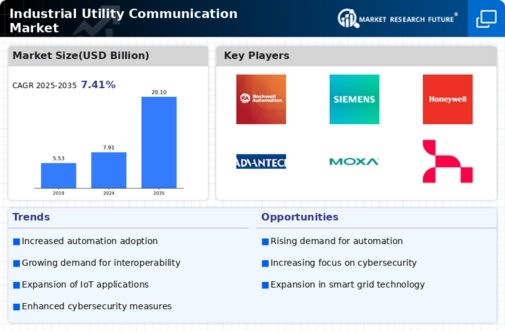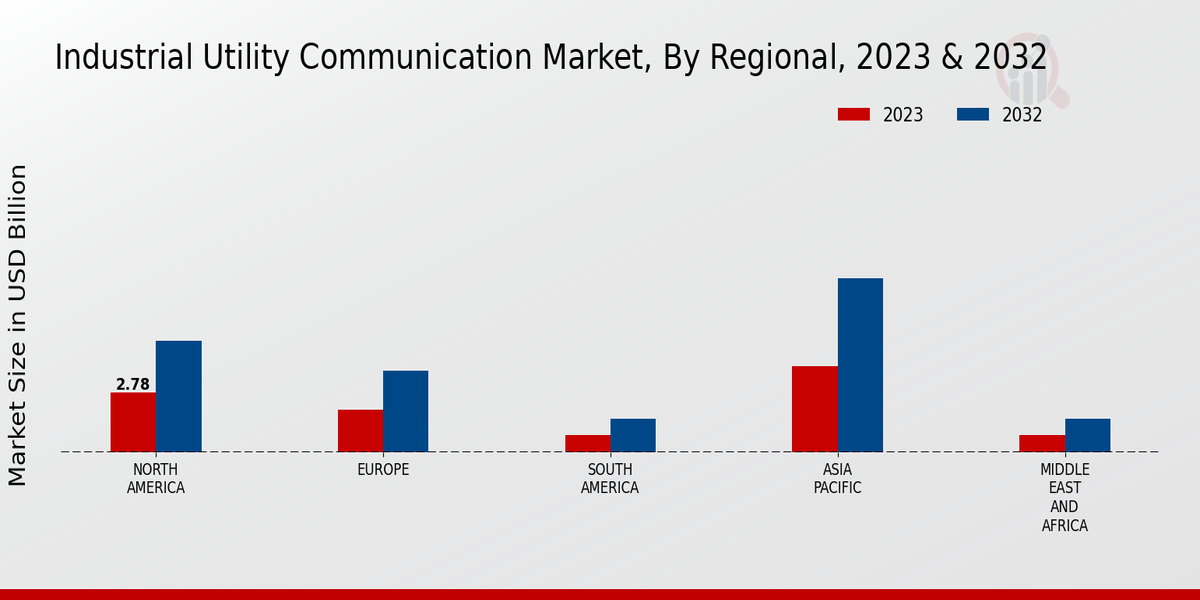Market Growth Projections
The Global Industrial Utility Communication Market Industry is poised for substantial growth in the coming years. With a market valuation of 7.91 USD Billion in 2024, projections indicate an increase to 20.1 USD Billion by 2035. This growth trajectory suggests a compound annual growth rate of 8.85% from 2025 to 2035, reflecting the increasing adoption of advanced communication technologies by utilities worldwide. Factors driving this growth include the demand for smart grids, regulatory support for modernization, and the integration of IoT solutions. The market's expansion is indicative of the broader trends towards digitalization and sustainability in the utility sector.
Growing Demand for Smart Grids
The Global Industrial Utility Communication Market Industry is witnessing a surge in demand for smart grid technologies. These systems enhance the efficiency and reliability of electricity distribution, allowing utilities to monitor and manage energy consumption in real-time. As of 2024, the market is valued at approximately 7.91 USD Billion, driven by the need for improved energy management and reduced operational costs. Smart grids facilitate better integration of renewable energy sources, which is crucial for meeting global sustainability goals. The transition towards smart grids is expected to significantly contribute to the market's growth, as utilities increasingly adopt advanced communication technologies.
Regulatory Support for Modernization
Regulatory frameworks across various countries are increasingly supporting the modernization of utility communication systems. Governments are implementing policies that encourage the adoption of advanced communication technologies to enhance operational efficiency and service reliability. This regulatory support is pivotal in driving investments in the Global Industrial Utility Communication Market Industry. As utilities comply with these regulations, they are likely to invest in new communication infrastructures, which could lead to a projected market growth to 20.1 USD Billion by 2035. Such initiatives not only promote technological advancements but also ensure that utilities meet the evolving demands of consumers.
Rising Investment in Renewable Energy
The Global Industrial Utility Communication Market Industry is significantly influenced by the rising investment in renewable energy sources. As countries strive to meet their energy needs sustainably, utilities are compelled to adopt advanced communication technologies that support the integration of renewable energy into the grid. This shift not only enhances grid reliability but also facilitates the management of distributed energy resources. The increasing focus on sustainability is likely to drive the market's growth, as utilities invest in communication solutions that enable efficient energy management. This trend aligns with global efforts to transition towards a more sustainable energy landscape.
Integration of IoT in Utility Operations
The integration of Internet of Things (IoT) technologies into utility operations is transforming the Global Industrial Utility Communication Market Industry. IoT devices enable real-time data collection and analysis, facilitating proactive maintenance and operational efficiency. Utilities are increasingly leveraging IoT solutions to enhance their communication networks, which can lead to improved service delivery and customer satisfaction. The adoption of IoT is expected to accelerate market growth, with a projected compound annual growth rate of 8.85% from 2025 to 2035. This trend indicates a shift towards more connected and intelligent utility systems, aligning with global digital transformation efforts.
Need for Enhanced Cybersecurity Measures
As the Global Industrial Utility Communication Market Industry evolves, the need for enhanced cybersecurity measures becomes increasingly critical. With the rise of digital communication technologies, utilities face heightened risks of cyber threats that can disrupt operations and compromise sensitive data. Consequently, there is a growing emphasis on implementing robust cybersecurity frameworks to protect communication networks. This focus on cybersecurity is likely to drive investments in advanced communication technologies that incorporate security features. As utilities prioritize the protection of their infrastructure, the demand for secure communication solutions is expected to contribute to the overall growth of the market.



 Source: Primary Research, Secondary Research, Market Research Future Database and Analyst Review
Source: Primary Research, Secondary Research, Market Research Future Database and Analyst Review

















Leave a Comment